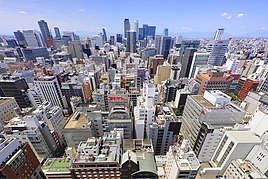
Back Нагоя ADY Nagoja Afrikaans ናጎያ Amharic ناغويا Arabic ناجويا ARZ Nagoya AST Naqoya Azerbaijani ناقویا، آیچی AZB Нагоя Bashkir Nagoya BAN
Nagoya
名古屋市 | |
|---|---|
 Interactive map outlining Nagoya | |
 Location of Nagoya in Aichi Prefecture | |
| Coordinates: 35°11′N 136°54′E / 35.183°N 136.900°E | |
| Country | Japan |
| Region | Chūbu (Tōkai) |
| Prefecture | Aichi Prefecture |
| First official recorded | 199 AD |
| City Settled | November 1, 1889 |
| Government | |
| • Mayor | Takashi Kawamura (Genzei Nippon) |
| • Representatives | 5 |
| Area | |
| • Designated city | 326.45 km2 (126.04 sq mi) |
| Population (June 1, 2021) | |
| • Designated city | 2,331,078 (3rd) |
| • Density | 7,140.6/km2 (18,494/sq mi) |
| • Metro | 10,240,000 (3rd) |
| Time zone | UTC+09:00 (Japan Standard Time) |
| – Tree | Camphor laurel (Cinnamomum camphora) |
| – Flower | Lilium |
| Phone number | 052-972-2017 |
| Address | 3-1-1 Sannomaru, Naka-ku, Nagoya-shi, Aichi-ken 460-0001 |
| Website | www |
| [2] | |
| Nagoya | |||||
|---|---|---|---|---|---|
"Nagoya" in kanji | |||||
| Japanese name | |||||
| Kanji | 名古屋 | ||||
| Hiragana | なごや | ||||
| Katakana | ナゴヤ | ||||
| |||||
Nagoya (名古屋市, Nagoya-shi, [naꜜɡoja] ⓘ) is the largest city in the Chūbu region, the fourth-most populous city proper with a population of 2.3 million in 2020, and the principal city of the Chūkyō metropolitan area, which is the third-most populous metropolitan area in Japan with a population of 10.11 million.[3] Located on the Pacific coast in central Honshu, it is the capital and most populous city of Aichi Prefecture, with the Port of Nagoya being Japan's largest seaport.
In 1610, the warlord Tokugawa Ieyasu, a retainer of Oda Nobunaga, moved the capital of Owari Province from Kiyosu to Nagoya. This period saw the renovation of Nagoya Castle. The arrival of the 20th century brought a convergence of economic factors that fueled rapid growth in Nagoya, during the Meiji Restoration, and became a major industrial hub for Japan. The traditional manufactures of timepieces, bicycles, and sewing machines were followed by the production of special steels, ceramic, chemicals, oil, and petrochemicals, as the area's automobile, aviation, and shipbuilding industries flourished.[4] These factors made the city a target for US air raids during World War II.
Following the war, Nagoya's economy diversified, but the city remains a significant centre for industry and transport in Japan. It is linked with Tokyo, Kyōto, and Osaka by the Tokaido Shinkansen, and is home to the Nagoya Stock Exchange as well as the headquarters of Brother Industries, Ibanez, Lexus, and Toyota Tsusho, among others. Nagoya is home of educational institutes such as Nagoya University, the Nagoya Institute of Technology, and Nagoya City University. Famous landmarks in the city include Atsuta Shrine, Higashiyama Zoo and Botanical Gardens, Port of Nagoya Public Aquarium, Nagoya Castle, Hisaya Ōdori Park, and Nagoya TV Tower, one of the oldest TV towers in Japan. It will be the third Japanese city to host the 2026 Asian Games, after Tokyo 1958 and Hiroshima 1994.
- ^ Demographia
- ^ 平成23年6月1日現在の世帯数と人口(全市・区別) (in Japanese). Archived from the original on 22 September 2011. Retrieved 19 June 2011.
- ^ "Population of Japan". Japanese Statistics Bureau. 2010.
- ^ "Nagoya | Japan". Encyclopædia Britannica. Retrieved 2020-04-28.
© MMXXIII Rich X Search. We shall prevail. All rights reserved. Rich X Search










